

- Call 908 543 4390
- Email
- Dr.Joni Redlich PT,DPT


by Dr. Ali
This week we are going to get BUGGY! There are two different types of people out there, those who think bugs are really cool and helpful and those who think bugs are the scariest beings to walk on earth. Although bugs may not be some people’s favorite things, there are so many out in the summer, doing their little buggy jobs here and there. They are all so different from each other in shape, color, and especially in HOW THEY MOVE! Because of this, we thought it would be fun to bring you and your kiddos BUGGY MOVES this week!
The Butterfly Flap: 
The Super Ant Pick Up:
The Jumping Spider: 
The Scooting Worm:
We hope you enjoy these summer bug-tastic exercises! We know you are “bugging” out that summer is almost over (so are we) but we are trying to enjoy every last bit. Happy summer everybody (and every buggy), have fun squirming, jumping, and flying like our little friends do!
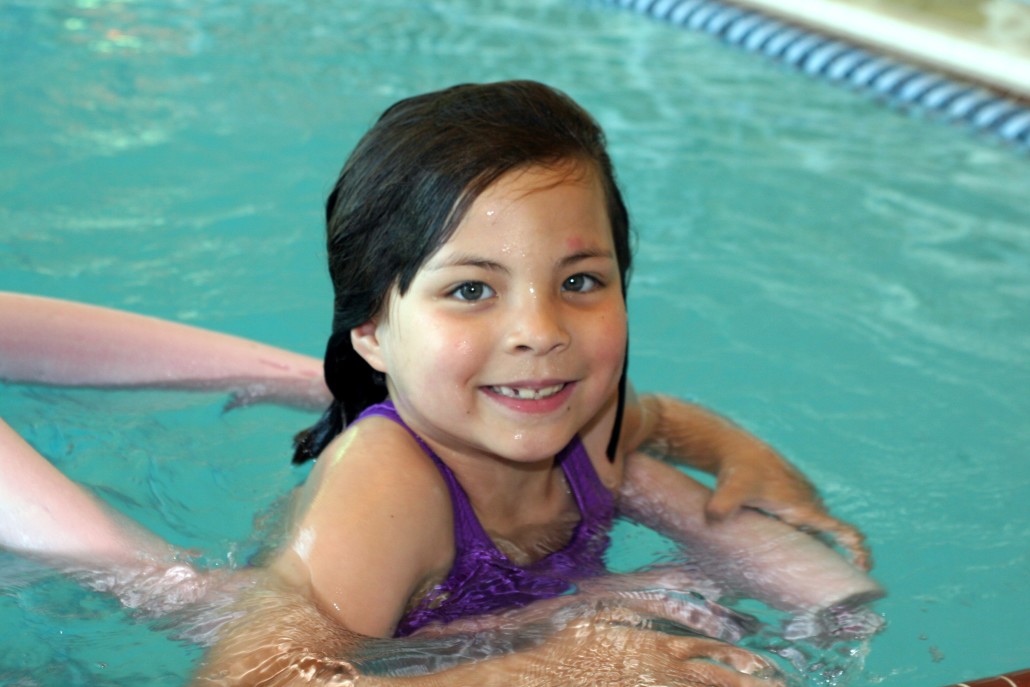
It is SUMMERTIME and with summer comes many fun outdoor activities.
One of these is Swimming!
Swimming is great for any kiddos who have low tone, neuromuscular conditions that affect movement strength or control, and for conditions that affect one’s joints. For any child who falls in one of the diagnostic categories listed above, moving in the water helps because buoyancy (aka what helps you float a little bit when you swim) takes away some of the gravity that typically weighs us down when we move! Though we love gravity to help keep our feet grounded when we move around on the earth, it does make it more difficult for kiddos who have low tone or neuromuscular related weakness to perform tasks that require them to move against gravity or require their muscles to have to sustain endurance against the forces of gravity throughout the day. For children who have a condition that affects their joints, the buoyancy of the water relieves a portion of the downward pressure exerted on their joints with every step on land.
Now, while buoyancy makes time in the water a little easier than time on land, we can’t forget about the other properties that make exercises in the water a true workout. Water is more viscous than air, meaning it is thicker and harder to move through. Not only is water thicker than air BUT water molecules love to stick together too, a property called cohesion. When the molecules stick together, again it makes them harder to move through than air, because as we are moving through water, we are resisting the force required to maintain the bonds between water molecules. I’ll bet you never thought you were breaking bonds every time that you go for a swim, but it’s neat right?!
That said, here are some activities that your kiddo can do in the shallow end of the pool (with supervision of course) that will help strengthen them for their time as a landlubber (aka when they are on land again):
Want to learn about more fun exercises for Summer? Visit our instagram @KidPT or check out more of our blog posts!

by Dr. Ali
Toe walking is something that is frustrating for many parents and their kids and our parents are often worried about their child’s balance or overall joint health of their feet and ankles as they age. The children are frustrated with always being told to walk on flat feet when they feel like they really can’t control how they are walking! We often hear “They’ll walk on flat feet when they’re thinking about it, but as soon as they stop thinking about how they are walking, they are back up on their toes again!” We hear this over and over again from parents. If you have been to another physical therapist for your child’s toe walking, often they just stretch, stretch, stretch them… your child is miserable and in pain AND there is often no change in their toe walking.
We look at toe walking a little differently. The body is a movement system if the system is not moving the way it is designed to, there must be a reason! The important question we therapists always ask is WHY! When a child walks on their toes, they are using a less efficient gait pattern than when a person walks with a heel to toe gait pattern. Our bodies are SMART and they are always trying to optimize their own movement efficiency naturally so that we can move with EASE. Basically all bodies take the path of least resistance, no matter what! That said, if a child is toe walking, it is DEFINITELY meeting an underlying need in their body, or else, they wouldn’t be walking that way. Toe walking IS their body’s path of least resistance. There is something blocking their body from walking with a heel toe gait pattern and making toe walking the easy way to move. THIS is where we pediatric PTs come in! There are many needs that their body might be trying to meet and we are here to help them fill in the little gaps that their body has not been able to do alone (up to this point).
Postural and Biomechanical
Sometimes, the origin of a child’s toe walking is related to their alignment and the way a child uses their core. When this is the primary reason for a child’s toe walking, we will often see the child leaning forward, belly out, with their whole center of mass (aka the middle of their body) positioned forward over their feet. If this is the primary driver of a child’s toe walking, then they need to re-learn how to use their belly muscles and how to re-align and control their whole body while moving before any changes are seen at their feet and ankles.
Sensory
Sometimes toe walking can have a large contribution from the sensory system. Within this realm there could be multiple different sensory needs their toe walking may be meeting. Let’s look at these different needs a little more:
Neuromuscular:
-Sometimes children who present with high tone or low tone can toe walk based on how their system regulates the tone in their muscles. High tone is frequently seen in children with Cerebral Palsy or children who have had a Traumatic Brain Injury, and in this sense, when the child moves or tries to walk, the tone in their calf muscles may increase to the point where they are walking up on their toes. In the case of low tone, similar to why children with impaired proprioceptive systems might toe walk, the child might be looking to stabilize joints which are more mobile. By toe walking, children with low tone are increasing their overall joint stability and thus the stability of their body while they move. Neuromuscular contributions to toe walking are more complicated as they require more time, patience, and retraining of the way the child regulates their tone while they move (which is often an automatic process and is only slightly understood by the medical community). The main reason why toe walking can be troublesome for this population, especially in the case of high tone, is that having the foot and ankle positioned in a pointed position while moving and likely while standing or resting too can create something called a contracture. A contracture is the term used when a joint loses movement in a certain direction to the point where it affects the intended function of that joint. When a contracture gets too severe, it might cause skin break down while a child is walking in certain shoes, which could lead to an infection down the line. Contractures are very hard to reverse once they occur and prevention is typically the preferred way to go!
If ANY of these descriptions (or a combination of these) sound like your child, they may benefit from physical therapy with the knowledge of how to treat idiopathic toe walking. Gone are the days of “stretching three times a day will make it better” because if you have done this with your child you KNOW that 9/10 time this does not work. At KidPT we treat idiopathic toe walking from the tummy out to the tips of the toes and don’t look over the potentially crucial contributing sensory factors. We will work with you and your child as a team to put the puzzle pieces together (and oh yeah did we mention they will have FUN while doing it). Stop stressing and start getting answers, come in to KidPT today for a Free Discovery Visit and see if WE are the right fit for YOU!
There are many fun activities your child can do on the playground to help facilitate gross motor development, develop coordination skills, and increase overall body strength. Below are just some examples of how to do this to get you started:
Playground Stairs & Ramps: Many playgrounds are equipped with a set of stairs that take kids all the way to the tippy top of a slide. Many of them also have landings that are the perfect height off the ground to allow the kids to jump down (this would be a height of around 16 inches). Practicing this skill lets kids use two feet together to take off and two feet to land at the same time. If they haven’t yet mastered a two footed landing, practicing by jumping down will help with the development of this skill!
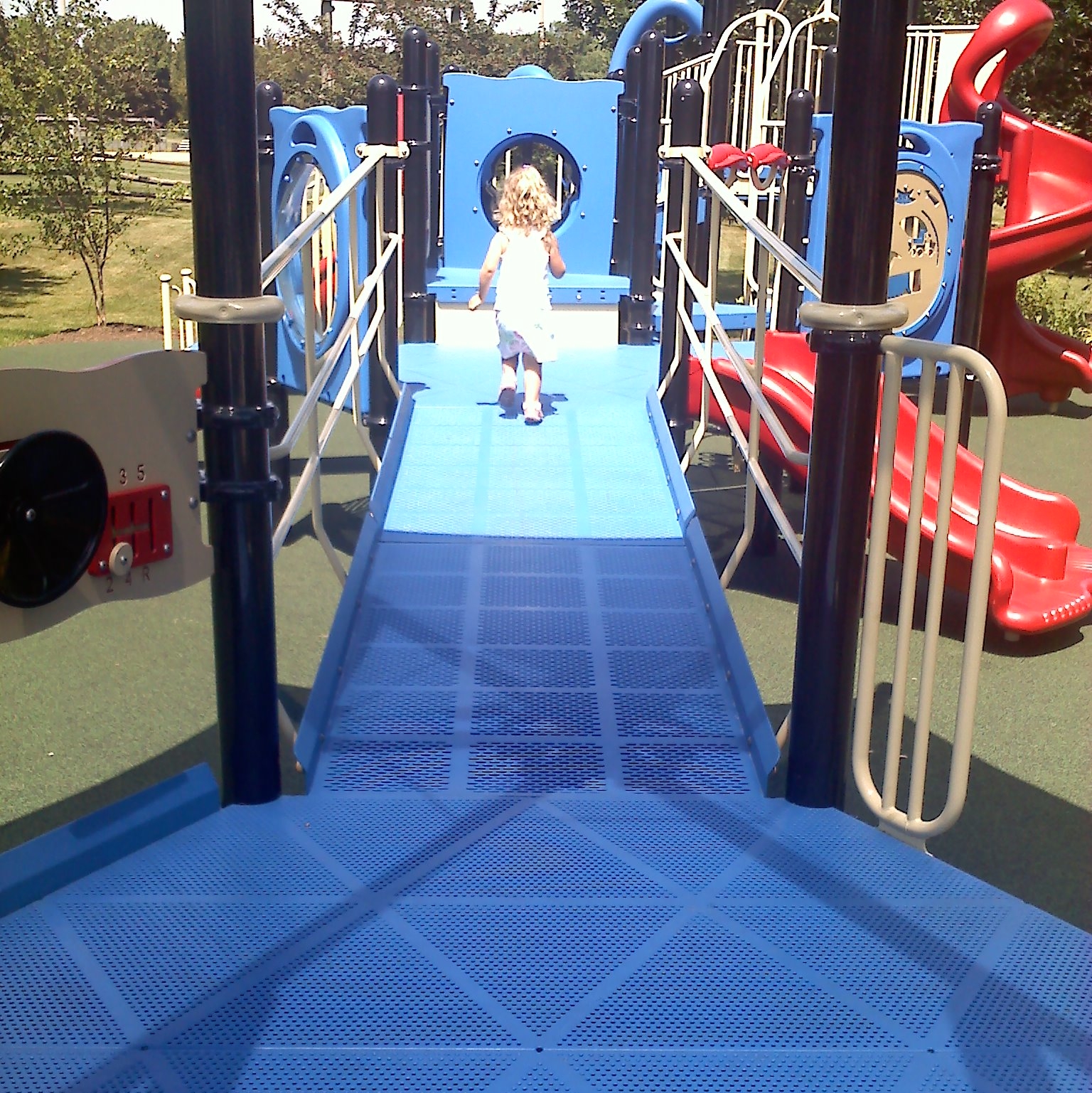
Climbing walls: Many playgrounds have climbing walls these days (which is really cool). Climbing walls are a great way to use and develop a child’s upper body and lower body strength, core strength, and whole body coordination. They have to use their brain to figure out where to place their feet and hands and then coordinate what they have figured out with their bodies to get their bodies to execute each motion. It’s a whole body team work activity!
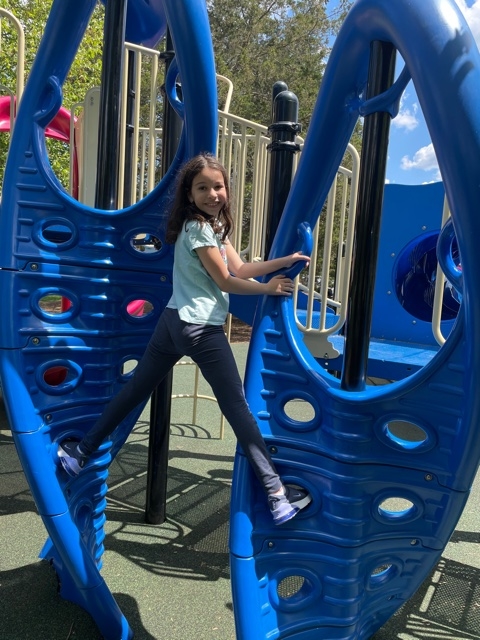
Swings: Swings provide a great foundation to work on postural control and balance using many muscles of the trunk, legs, and arms to do so! The swinging motion requires a child to move their body in opposition to the motion of swing to continue to generate momentum. Each transition of their body between back and front uses a give and take of the front versus the back muscles that help support their spine, hips, shoulders, and etc. Negotiating their body in this way helps teach them how to use these postural muscles and how much to use on each side to create a desired movement. In other words, it teaches them how to coordinate these muscles.
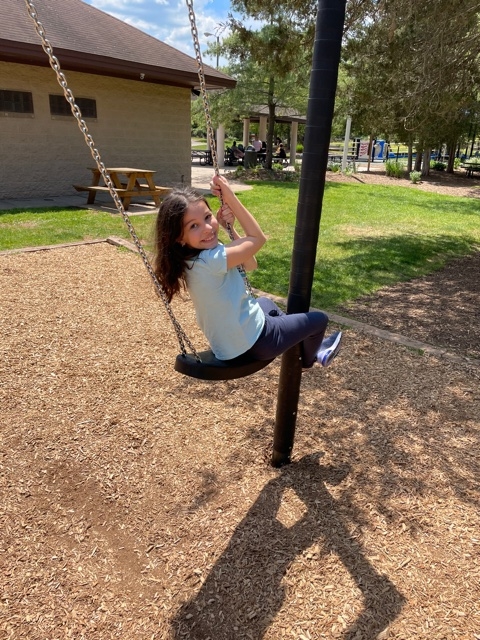
Tubes: Tubes are a great way to build upper body strength and use the core in a way we typically don’t once we learn how to walk. You can encourage your child to be creative with their movement in tubes too, not only crawling forward but crawling backward, moving in a bear crawl, trying a commando crawl (on their belly), or even crab walk!
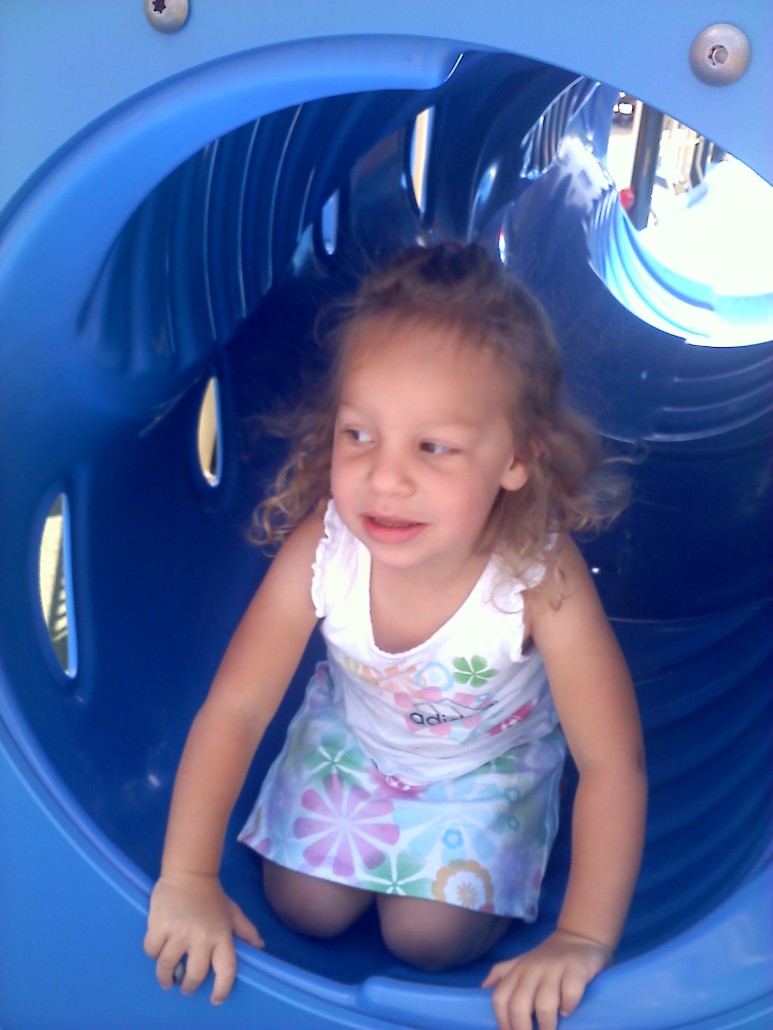
Slides: Last but not least, slides are also a great tool to help develop body strength and coordination. When a child slides down a slide, they have to keep their body upright in a sitting position. While they are doing this, inertia is pushing their trunk backward and they have to use their core to stay upright! When they land at the bottom, they again have to coordinate the front and back core muscles to keep from falling forward as the force of inertia is decreased on their trunk (when the movement stops). They also must stop themselves with their legs without losing their balance, which requires a lot of strength, control, and coordination of the legs and body!

We hope you have so much fun on the playground this June! Remember to always supervise your kiddos while they are playing and stand close to them while they are trying new and difficult skills, in case they need your help! At the same time, remember that the playground is the perfect place for kids to take risks, challenge their skills and learn how to problem solve.
If your kiddo is having trouble with coordinating or performing some of these gross motor skills, give us a call at KidPT to schedule a free Discovery Visit today! We would love to talk to you about your child’s potential PT needs!
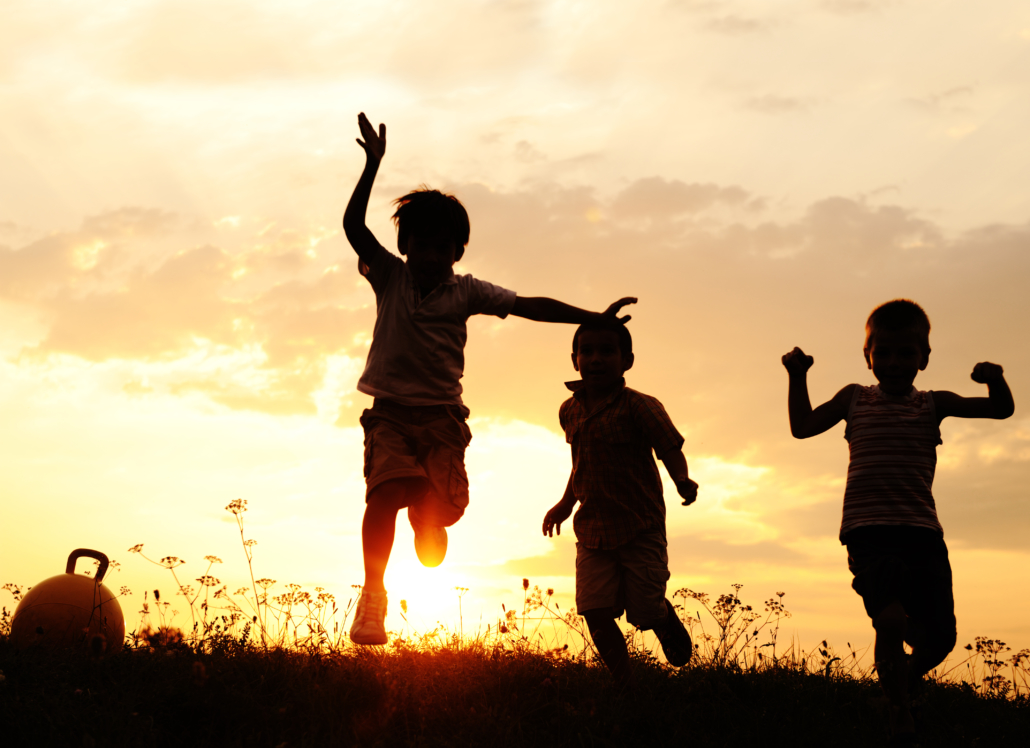
Happy JUNE! June is in full swing and with this fun Summer month comes warmth, and lots of SUNSHINE! To celebrate this sunny month, here are three fun in the sun exercises to get ready for summer! Yay!
We hope you have fun doing these three simple activities and that you are excited for the start of SUMMER!

Did you know… there may be a link between your child’s core control and their level of anxiety? When we learned about this link, it just about blew our socks off… and then we quickly put them back on because it made so much sense to us!
People are always saying that core control and strength is SOOO important for kids and adults to move efficiently and to support our bodies. This is true and when someone has difficulties keeping their bodies stable and centered in one place for a bit of time, it is often related to their core strength or core control. This we usually expand beyond the idea of the core alone and relate this difficulty controlling the body to the term “postural control”. If you read our blog on a regular basis, you know that we talk about postural control ALL THE TIME! We talk about it so much because it is so important to everyday life and our ability to move through it with ease. If we can’t control our bodies in a still state, hold our bodies in an aligned posture, and activate our core in the right way, performing higher level tasks is HARD! If your child is focusing SO much on maintaining control of their body, any tricky coordination or tricky mind components of the task may be a very big ask and that specific task may be very hard for them to do.
We see this and recognize this in many of the kiddos we treat, which is why we are always mindful of adjusting a task to meet them where they are at that given point in time. Although we are always thinking in this way, what we hadn’t necessarily thought about was how difficulty with postural control and core activation may be linked with emotions, specifically elevated levels of anxiety.
HOW you ask? In a study performed comparing the balance and postural reactions of children with anxiety to children without anxiety, it was found that during simple balance tasks, children with anxiety exhibited greater postural sway with less variety when compared to children without anxiety. The differences between the two groups grew larger as the balance tasks became more challenging. The researchers concluded that the pattern of postural sway they saw suggested that decreased stability during balance tasks causes the task to demand more attention. This, they felt, may explain the link between decreased balance and higher levels of anxiety in children.
SO, if your child has more trouble controlling their posture at baseline, they may be devoting more attention to postural control at all times. When they send more attention to their body in that way, it takes up cognitive power that they need to complete hard school tasks or that they need for harder motor tasks… AND life demands them to do these higher level tasks ALL THE TIME. This has the potential to increase their anxiety and overall frustration when asked to do these challenging things. As is stated above, researchers predict that this may be why these two things are linked, because the mind is being forced to devote attention to SO MANY hard things all at the same time, and that shifting attention in this way is STRESSFUL. This is especially so because as children shift some of the attention they are giving to maintain their postural control away from the body and toward another task, they may start to lose their balance, forcing the brain to give that attention back AND then they complete the big task in a slightly haphazard way.
If your child has trouble with balance, they may benefit from physical therapy. We look at each child as a whole being and consider more than just the basics of balance and strength, because we as human beings are so much more than just these things! If you are curious about physical therapy for your child and want to test the waters, come in for a free Discovery Visit to see if we are the right fit for you, your family, and your child. Don’t worry, there are so many things in life that make us stressed and nervous but we have your back and we are here for you! Breathe in and out , everything is going to be okay!
Resources:
Everyone is always saying “Exercise is good for you!”… yeah yeah we’ve all heard that before. We know that exercise makes our bodies healthier BUT did you know it can make your mind happier too?? This month is National Mental Health Month. We wanted to raise awareness this week by helping you understand WHY exercise can lift you and your child’s moods and help to reduce unwanted stress at the chemical level (aka within the brain)!
When we exercise, our brains release something called ENDORPHINS. Endorphins are released when our body feels physically exerted, which usually happens when we start to sweat, our heart rate goes up, and our cheeks turn pink! When our brains release endorphins, this helps to decrease our responsiveness to pain and also relieves stress within the brain. Also when we exercise, our brains release many mood-boosting chemicals. These are called DOPAMINE, NOREPINEPHRINE, and SEROTONIN. These brian chemicals are all responsible for regulating our mood and promoting internal happiness on short and long term scales. One of the really cool things about Serotonin is that when we exercise regularly, the levels of serotonin in the brain have been shown to increase over a longer period of time. This promotes a greater sense of well-being, which can help your kiddos feel very secure.
Another great benefit of exercise is that it decreases potentially harmful stress chemicals, specifically adrenaline. With regular exercise, the levels of adrenaline in the brain become more balanced. If your kiddo exercises on a regular basis, this may help them feel less of this hormone which tends to make people very stressed out when over produced.
We know hormones and brain chemicals can get very complicated very quickly BUT the bottom line is….Regular exercise can make your and your child’s brain happier and less stressed. No matter what that exercise might look like for you and your kids, as exercise comes in many forms for many types of bodies, it is important to move in a way that is healthy for your and your child’s body as much as is possible!
Looking for ideas to jump start your family’s movement today? Watch this youtube video created by Coach Corey Martin, he will have the whole family ducking, dodging, and jumping over imaginary obstacles in no time!
Information retrieved from:
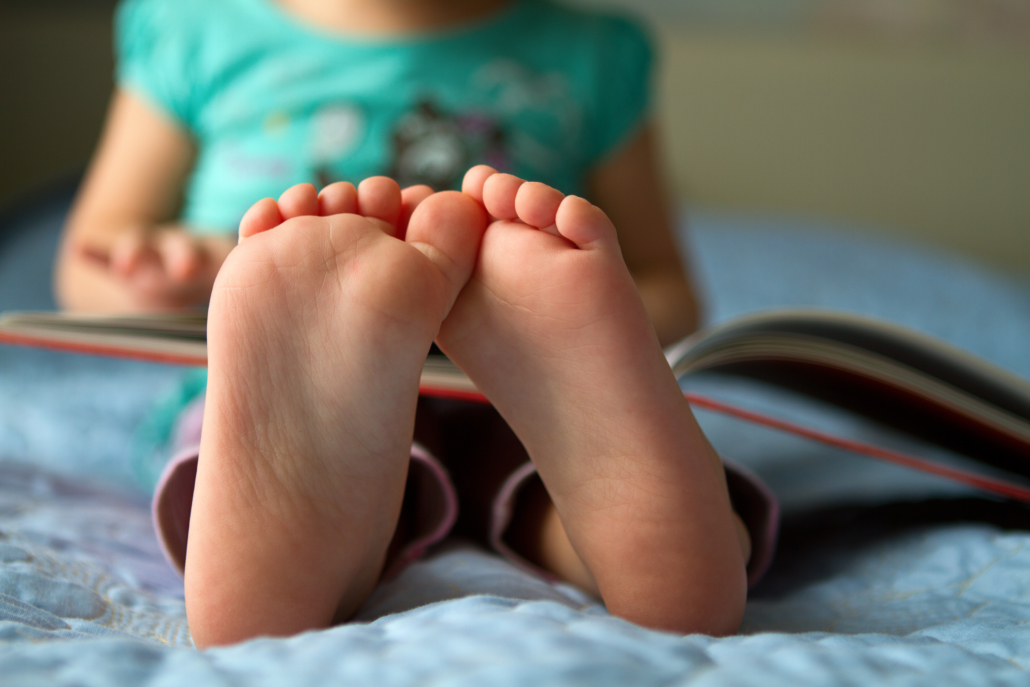
 Feet come in many different variations and all feet are different! As physical therapists, when we take a first look at your child, we always make sure to look at their feet along with the rest of their body. Sometimes the way the feet are structured OR the way they move when your child stands on them can make balance VERY hard. What do we mean by this? Sometimes the feet have a little bit of extra motion to one side or the other. When this happens, the heel will often make a C shape, and that C can either point out or point in when you are looking at your child’s foot from the back. If the C’s point out, with the curve of the C in the middle, they may also have a “dropped arch” or a “flat arch”. If it looks like your child’s arch is close to the ground when you look at the inside of their foot, they may have arches that are more on the “flat” side.
Feet come in many different variations and all feet are different! As physical therapists, when we take a first look at your child, we always make sure to look at their feet along with the rest of their body. Sometimes the way the feet are structured OR the way they move when your child stands on them can make balance VERY hard. What do we mean by this? Sometimes the feet have a little bit of extra motion to one side or the other. When this happens, the heel will often make a C shape, and that C can either point out or point in when you are looking at your child’s foot from the back. If the C’s point out, with the curve of the C in the middle, they may also have a “dropped arch” or a “flat arch”. If it looks like your child’s arch is close to the ground when you look at the inside of their foot, they may have arches that are more on the “flat” side. Arches that are on the “flatter” end of the spectrum are not necessarily all bad, they absorb forces nicely when someone walks or runs. With enough foot strength, an arch that is on the flatter side can be very strong and can maintain that strength when challenged by difficult activities like walking, running, jumping, etc. When flat arches DO become a problem is when they start to affect a child’s balance and development of gross motor skills, like standing and walking.
Arches that are on the “flatter” end of the spectrum are not necessarily all bad, they absorb forces nicely when someone walks or runs. With enough foot strength, an arch that is on the flatter side can be very strong and can maintain that strength when challenged by difficult activities like walking, running, jumping, etc. When flat arches DO become a problem is when they start to affect a child’s balance and development of gross motor skills, like standing and walking. Hi everyone! This week we are here to bring you insight on another way Physical Therapy can help children with Autism Spectrum Disorder (ASD). Like we discussed last week, many people do not know how PT can help individuals within the ASD community. Well, we are here to tell you just how we can help (PART 2)! Not every individual within the ASD community has motor difficulties, but some individuals within the ASD community need a little bit of help to overcome different motor challenges that may be preventing them from flourishing as their best selves!
Some children with ASD love to move move move! While movement may just be something they love love love to do, sometimes they may be moving without stopping because they have trouble STOPPING their own body movement. Just like we discussed last week, this is often related to postural control as well. Postural control affects their balance and one’s ability to keep their body stable in one place for a given period of time. If your child has difficulty with postural control, it may cause them to stand up and then sit down, and then stand up again, in rapid succession. They may also be more inclined to run than walk OR when they are walking, their steps may be ALL over the hallway, like they are losing their balance. Like we talked about last week, these are both strategies kids may use to keep themselves from falling, because believe it or not, moving SLOWLY takes so much CONTROL of the body. Slowing down may be too much work for your child’s body so it is easier for them to move fast OR just to keep moving in general, because then they are less likely to fall.
On the other hand, sometimes children with ASD have trouble starting new movements. This may happen when they are doing something like walking from standing still, reaching for an object from standing still, or transitioning from walking on a flat surface to walking up the stairs. It may seem like your child is refusing to move or refusing to do something hard, like climbing the stairs, when in reality they may be stalling because their brain is having trouble telling their body to GO! We in the PT world call this idea “movement initiation” and most of us take our own easy ability to initiate different movements for granted. Children who have trouble with movement initiation try very hard to start a movement, but sometimes it takes a bit OR they need some outside help to do it. This “outside help” is referring to things outside their brain, and some examples of this would be rainbow stripes on steps giving a visual cue to walk OR a song with a good beat, giving a sound cue to keep on moving!
The goal of physical therapy in either of these realms is to generate either more postural control or easier movement initiation. How does PT do this, you ask? By making new neural connections in the brain and central nervous system which then inform the rest of the body. By making these changes in the brain and body, both processes of postural control and movement initiation become automatic processes. This way, your child does not have to think about it too hard and their body will do it automatically. This will let your child do other important tasks, like learning in school, eating a meal, or climbing the stairs, without their brain and body having to work so hard. By making these processes automatic, they can move with greater ease and freedom!
If any of these descriptions sound like your child, call us at KidPT today for a free Discovery Visit, where we can discuss if physical therapy is the right fit for your child and why!

Earth day is April 22nd this year, and we wanted to prepare all of the kiddos out there with ways to celebrate! We’ve said it before and we will say it here again, getting outside is great for so many things, including calming and attention (see our blog post about this HERE). It is also great for promoting movement of many varieties!
Here are some fun, Earth Day themed activities to get you and your family moving in the great outdoors:
Happy Earth Day everyone! Go out there and explore the great outdoors! We hope this post helps generate some ideas for combining movement and activity with the outdoors for some teachable moments so that your kids can learn why we celebrate the green world all around us!
